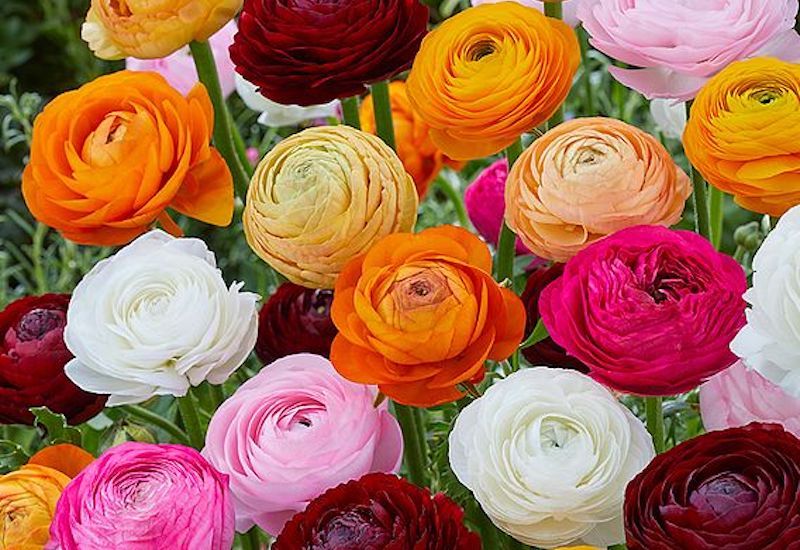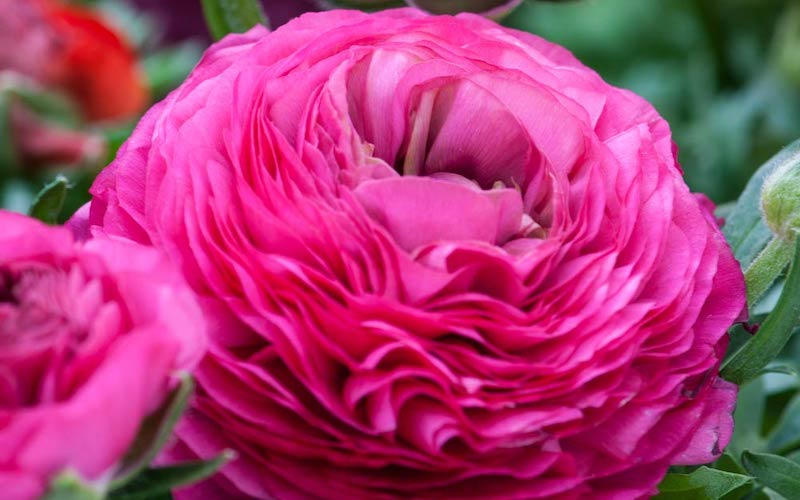Here’s our ultimate guide to planting and growing ranunculus bulbs. Producing lush foliage and stunning rose-clustered blooms from spring to early summer, ranunculi come in a huge range of colours and shapes. They look fantastic growing through beds and borders, or planted en masse in patio containers. The flowers are also ideal for cutting, and last for weeks in a vase.
Here’s how to plant, grow and split ranunculus bulbs for spectacular spring bulb displays.
What are ranunculi?
Ranunculus is a genus of flowering perennial plants, found in the same family as buttercups and larkspur, and native to southern Europe and southwestern Asia. The most commonly grown ornamental ranunculus is R. asiaticus, also known as a ‘persian buttercup’ or simply ‘ranunculus’.
Ranunculi are usually grown from bulbs (tubers), which have a claw-like appearance. They are available at the beginning of autumn or early spring. Alternatively, ranunculi can be raised from seed or split from existing mature plants.
When should I plant ranunculus bulbs?

Ranunculus bulbs can be planted in either spring or autumn
Image: Shutterstock
Provided you live in a mild area, the best time to plant ranunculus bulbs is autumn. The flowers will appear the following spring. Autumn-planted bulbs tend to be more prolific than spring-planted ones, and flower for longer.
You can also plant your bulbs in the early spring after the risk of frost has passed. You’ll get a slightly shorter period of flowers, which should appear in late summer, roughly 90 days after planting.
Where to plant ranunculus bulbs

Create extravagant displays by planting ranunculus en masse
Image: Ranunculus ‘Mixed’ from Suttons (© Visions BV, Netherlands)
In milder areas, plant your ranunculus bulbs straight outdoors in autumn to overwinter in their flowering positions. Ranunculi reach a height of between 20 and 30cm tall, so place them at the front of a mixed border for lovely compact colour.
If you live in a colder area that regularly sees hard frosts through the winter, plant your autumn bulbs in containers to overwinter in a polytunnel or greenhouse. Move your container grown ranunculi outdoors come spring, and place in a prominent position to enjoy.
How to plant ranunculus bulbs

Always ensure you plant your bulbs ‘claw’ side down
Image: Tanya Hamster/Shutterstock
Place your ranunculus bulbs in water at room temperature for a few hours to hydrate them before planting. This stage isn’t necessary, but it will speed up the sprouting process. After soaking, the bulbs should increase in size and have a plump look.
Prepare the soil by mixing in well-rotted manure or good quality general purpose compost. Plant your hydrated bulbs about 2 to 3 inches deep with the ‘tentacle’ side of the bulb facing down. Choose a spot in full sun, away from strong wind, and with good drainage. The bulbs should be spaced about 9 inches apart to give them room to grow, and watered in well. Mark the spot with a wooden label so you don’t forget where they are!
For container grown ranunculi, add plenty of grit to the base of the pot before filling with a quality multipurpose compost. Add some extra grit to the compost to improve the drainage. To plant the bulbs, follow the same process as above, making sure that the ‘tentacles’ point down. Label the pot after watering in your bulbs, and place it in a sheltered, sunny position away from strong wind.
How to care for ranunculi

Deadhead your ranunculus to keep the flowers coming
Image: Ranunculus ‘White’ from Suttons (copyright Floramedia)
After planting, make sure you keep watering the developing plants well, especially during dry periods. However, don’t allow the soil to become waterlogged as this may cause the bulbs to rot. Deadhead your ranunculi regularly during flowering to encourage more blooms and to allow the bulbs to retain energy for next year instead of putting it into seed production.
If your plants are threatened by frost, protect them with a layer of horticultural fleece, or move your containers into a sheltered area. Alternatively, lift your outdoor planted bulbs after the foliage has died back in autumn, and store them over winter in a dry cool place, ready to replant in the spring.
How to lift and divide ranunculus bulbs

Wait until at least the second year before attempting to split ranunculi
Image: Shutterstock
Propagate your plants by splitting them with a garden fork. You can do this in the autumn, or in spring once all risk of frost has passed. Gently tease the roots apart to avoid damage and carefully separate the plants. Once split, replant the sections throughout sunny borders, or into pots of well drained soil. Incorporate some well-rotted manure if possible, and remember to protect them from frost.
Best ranunculi varieties to try

Ranunculi bloom from spring to early summer and look great at the front of borders
Image: Ranunculus Bulbs – Red from Suttons
Ranunculi have a great ‘shelf life’ making them ideal for cut flowers, so try growing a broad mix of varieties for cutting and displaying indoors. Reds and pinks look great when planted together, or try a bright yellow mixed with white Ranunculus for a sophisticated spring display.
The ‘peony’ type ranunculi produce very dense blooms with layers of paper thin petals on upright stems, ideal for cutting or enjoying at the front of the border.
We hope you’ve found our guide useful. Check out all our growing guides for more tips and advice on growing flowers and vegetables. Keep an eye out for our latest offers, new ranges and competitions!
Lead image: Ranunculus Bulbs – Pink
Last Updated on September 15, 2025 by Suttons Horticultural Team






hi,i have a large selection of ranunculus tubers/bulbs. i soaked them the night before and was amazed that thin white roots developed. i placed them in about 1 & half inches of good soil but nothing has happened in 3 weeks. could you please advise me,thanks.
I’m growing ranunculus for the first time. I planted a large number of bulbs in autumn, which have all come up and are now small leafy plants about 6cm tall. When can I move them to the border? And how do I go about this as currently the plants are quite close together?
I tried growing Ranunculus for the first time this year and I presprouted, which worked perfectly. What didn’t work is the fact that Ohio’s weather goes from 0 to 100 in .5 seconds. They were doing so well and then the heat kicked in, left, came back and now we are in summer. I think that I am going to leave them in the pots that they are in and just over winter them in my greenhouse. Great tips.
I bought some ranunculus plants from garden centre in flower . Can I plant out into tubs in April and how long will flowers last .
Hi Clodagh, Ranunculus can be planted out now as they are cool-season flowers growing best in spring-like temps of around 12 degrees C.
We hope this helps!
Best regards,
The Suttons Team
Hi,i would really appreciate some advice on when i can plant out my over wintered ranunculus that were sown late sept.I kept them in the poltyunnel and fleeced when very cold.They are now in about 6″ pots and some about to flower .Im anxious to get them into the ground as need to free up space shortly.
Hi Chantelle, the Ranunculus are ground hardy in warmer areas and best over wintered in a greenhouse or cold frame and brought out in the spring to a sheltered position protected from strong winds. A fleece should provide a good level of protection however, and there is no reason not to expect flowers in the spring.
Best regards,
The Suttons Team
I’ve managed to over winter ones I bought last year that didn’t flower very Well, my fault entirely. They haven’t died down at all, have been fleeced when the temperature dropped. Will these still flower if I start feeding them once a week in spring?
Hi Carol, it is not the right time to split Ranunculus now, this should be carried out in autumn or spring once risk of frost has passed.
Once split, plant in well drained fertile soil in full sun and incorporate some manure if possible. If planting in pots put grit in the bottom, use good quality multi purpose compost mixed with extra grit and place the pot in a sheltered sunny position away from strong and cold winds.
Hope this advice is helpful to you.
Best regards,
The Suttons Team
When can I split the ranunculus? Mine are coming up again after 3 years. Is it too late to do this in January?
After hydrating and planting do you water the bulbs? I found the information helpful .When established then you start watering presumably